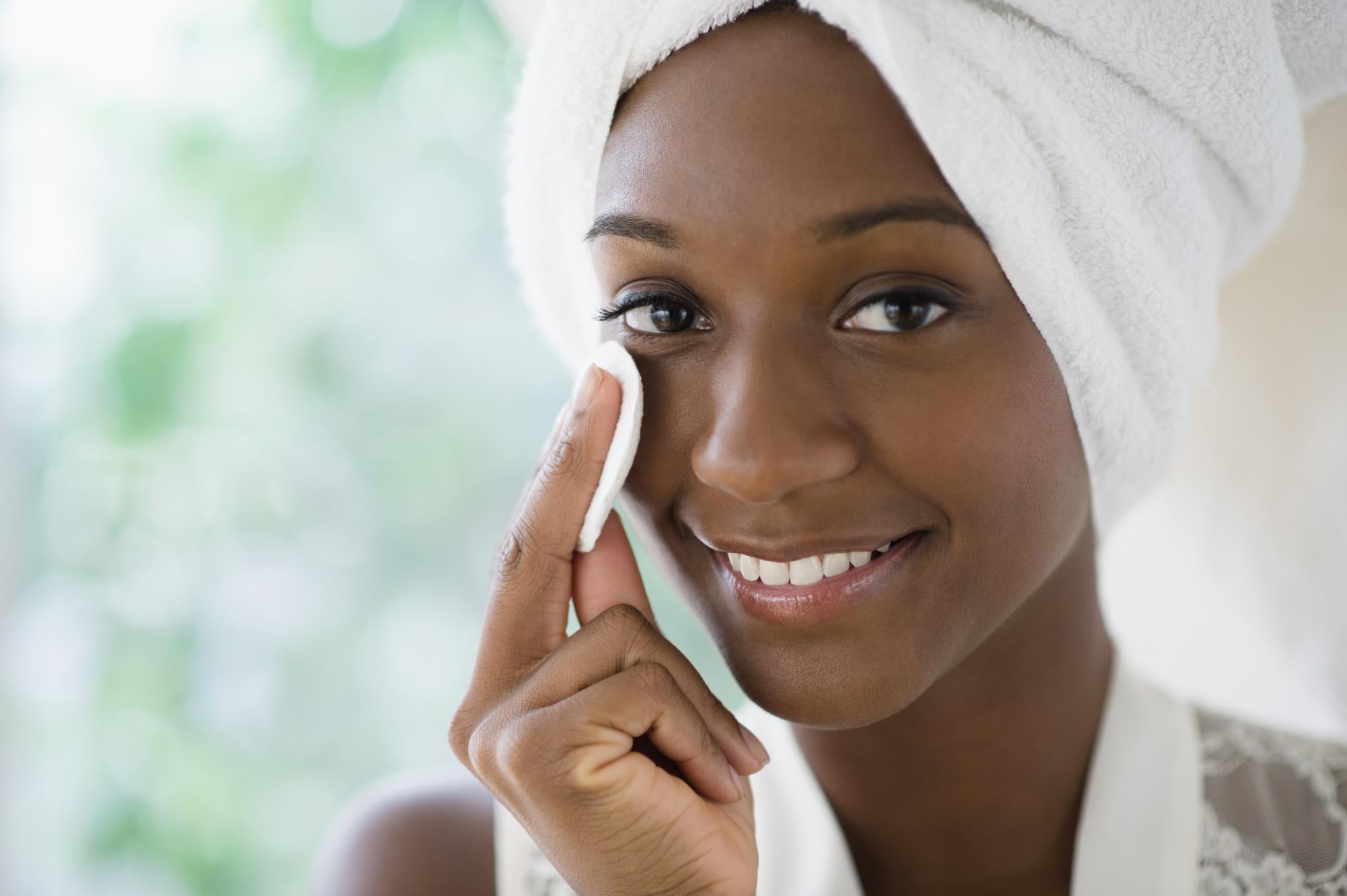
There are a lot of terms that can make perfecting your skincare routine confusing. Here’s a simple resource with all the terms you’ll ever need to know.
Subscribe to our daily newsletter for the latest in hair, beauty, style and celebrity news.
Acne
A skin condition characterized by blackheads, pimple outbreaks, cysts, infected abscesses, and scarring most commonly found on the face, back, shoulders and chest.
Abscess.
A deposit of pus on the skin that, in most cases, causes swelling and inflammation around it.
Alpha Hydroxy Acid (AHA)
Ingredients that aid exfoliation by weakening the bonds between cells in the outer layer of dead skin, allowing the normal shedding process to occur faster. By helping new cells surface, they improve skin texture, unclog pores and facilitate absorption of skincare products.
Amino Acids
The structural units that make up proteins and in essence are natural peptides. They stimulate collagen production of collagen, increase skin moisture retention, infuse skin with antioxidants and strengthen skin’s barrier.
Antioxidant
Vitamins, minerals and enzymes that can help to nourish skin cells and prevent and repair damage to your tissue.
Astringent
A water-based solution containing alcohol used to clean the skin and close pores. Astringents are usually applied after cleansing but before moisturizing.
Benzoyl Peroxide
An antibacterial ingredient that penetrates pores and kills bacteria causing acne and inflammation.
Beta Hydroxy Acid
An acid that aids exfoliation by weakening the links between cells in the outer layer of dead skin, allowing the normal shedding process to occur faster. Also known as salicylic acid.
Blackhead
A pore or hair follicle that becomes clogged with dead skin cells and excess sebum and becomes blackened at the surface due to air exposure. Also known as an open comedo.
Botox
A cosmetic injection that temporarily diminishes or removes lines, wrinkles and creases in the face.
Ceramides
Natural lipids in the skin that bond surface skin cells together.
Chemical Peel
A dermatological procedure performed by dermatologists to improve the texture of the face by removing the top layer of the skin to help minimize the appearance of sun damaged skin, irregular pigment, and scars.
Citric Acid
A naturally-occurring alpha hydroxy acid derived from the fermented sugars of citrus fruits. Citric acid helps speed up cell turnover and renewal.
Collagen
The protein in skin that gives it firmness and structure. With age, collagen is produced more slowly and degenerates more quickly. It is also diminished by sun damage, pollution, free radical damage and genetics.
Comedone
An acne blemish with a white or yellowish head on the skin, also known as a whitehead.
Comedogenic
A term used to describe cosmetics that cause comedones, usually referred to as blackheads or whiteheads.
Cystic Acne
A severe form of acne that forms deep lesions filled with pus or fluids.
Dermis
The middle layer of the skin consisting of the blood vessels, hair follicles, collagen and sweat glands.
Elasticity
A term used to describe the ability of the skin to stretch and return to its normal state. A loss of elasticity is natural with aging and leads to sagging, lines and wrinkles.
Elastin
One of the skin’s two structural proteins, the other being collagen. Elastin gives skin its flexibility, enabling it to stretch, then snap back into place.
Emollient
An ingredient that softens the skin and is similar in structure to natural lipids found in the skin. Emollients help prevent dryness and soothes irritated skin.
Enzyme
Enzymes are special proteins that exist in the cells of all living beings. Their purpose is to facilitate naturally occurring biochemical reactions.
Ephelis
Clusters of brownish spots on the skin caused by deposition of pigment that typically appear on sun-exposed areas. Also known as freckles.
Epidermis
The most outer layer of the skin that is exposed to the environment.
Exfoliant
An ingredient or device that sloughs off dead surface cells to stimulate cell turnover and improves skin texture, tone and radiance.
Extraction
The process of deep cleaning a clogged or compacted pore (blackhead) by manual or mechanical means.
Follicle
The structure from which each hair grows on human skin.
Free Radicals
Molecules that destroy collagen and lead to wrinkles, lines, sagging and wrinkles. Free radicals are often caused by the sun and other environmental aggressors, such as pollution and smoke.
Glycerin
A substance found in personal care products that improve smoothness by providing lubrication and as a humectant. Also known as glycerol.
Glycolic Acid
An alpha hydroxy acid (AHA) used to exfoliate skin and treat fine lines, acne, blackheads, and dullness. Glycolic acid helps break down bonds in the top layer of skin, dissolving sebum and other substances that clog pores.
Humectant
A non-oily substance that absorbs moisture from the air, retards evaporation and helps hold water, humectants are used in personal products and food to help retain moisture.
Hydroquinone
An ingredient used to lighten the skin. Hydroquinone is effective in lightenting dark spots and blemishes resulting from hyperpigmentation.
Hyperpigmentation
The darkening of an area of the skin caused by an increase in melanin. Hyperpigmentation may be caused by sun damage, acne inflammation or other skin injuries.
Inflammation
The reaction of the skin that causes redness, swelling, heat, and pain due to injury, infection, or allergic reaction.
Keratosis Pilaris
A genetic skin condition where rough bumps appear on the back, upper arms and thighs. It occurs because excess keratin, a natural protein in the skin, accumulates within the hair follicles, forming hard plugs.
Lactic Acid
A naturally-occurring alpha hydroxy acid (AHA) derived from dairy products that helps speed up skin cell turnover and renewal.
Lipids
Natural fats which play an essential role in maintaining healthy skin hydration and structure. Skin lipids include ceramides, cholesterol and fatty acids.
Lipoma
A benign tumor under the skin composed of fatty tissue.
Lycopene
Antioxidants derived from red fruits and vegetables, including watermelon, red grapes, red peppers, beets, pink grapefruit and especially tomatoes. Extremely effective at fending off environmental free radicals and preventing the breakdown of collagen.
Melanin
The pigment that gives skin and hair its color.
Melanoma
A form of skin cancer that begins in the cells that make the pigment melanin. Melanoma causes the majority (75%) of deaths related to skin cancer.
Microdermabrasion
A process where the top layer of skin is gently abraded away. Microdermabrasion is used to treat dull skin, reduce mild acne scaring, smooth fine wrinkles, even skin tone and exfoliate plugged pores. Microdermabrasion stimulates the production of skin cells and collagen.
Non-Comedogenic
A term used to describe products not tending to clog pores or cause comedones, usually referred to as blackheads or whiteheads.
Panthenol
A form of Vitamin B5, panthenol is a moisturizing agent which serves to help smooth rough, cracked, and dry skin.
Parabens
Ingredients that act as a preservative in cosmetics and personal care products. Parabens prevent the growth of fungi and bacteria that could cause products to spoil, thus increasing their shelf life.
Petroleum (petrolatum)
An emollient which helps soften skin and reduce dryness.
Pore
A tiny opening on the surface of the skin.
Retinoid
A topical prescription cream made from vitamin A derivatives that increases cell turnover, stimulates collagen production, and exfoliaties the top layers of skin. There are three prescription-strength retinoids: tretinoin (brands include Atralin, Avita, Retin-A, Retin-A Micro, Renova), tazarotene (Avage, Tazorac), and adapalene (Differin).
Rosacea
A skin condition that causes inflammation all over the face
Salicylic Acid
An acid used to remove the outer layer of the skin, thereby enhancing penetration and effectiveness of ingredients. Salicylic acid aids exfoliation by weakening the bonds between cells in the outer layer of dead skin, allowing the normal shedding process to occur faster.
Sebaceous Glands
Microscopic glands in the skin that secrete oil to the surface of the skin.
Sebum
An oily substance secreted by the sebaceous glands that helps prevent hair and skin from drying out.
Serum
A lightweight skincare product formulated with a high concentration of active ingredients.
Toner
A toner is a water-based solution that is typically alcohol-free and uses humectants to keep the moisture in the upper layers of the skin to prevent skin dehydration. Toners are usually applied after cleansing but before moisturizing to balance the pH of the skin.
UVA Rays
UVA rays are responsible for skin aging and wrinkling and can contribute to skin cancer. Because UVA rays pass easily through the ozone layer, they make up the majority of sun exposure. UVA rays can pass through clouds, glass and clothing, but unlike UVB’s, they are painless.
UVB Rays
UVB rays are very high in energy and are responsible for tanning and sunburns. They can affect the immune system and also contribute to skin cancer.
Vitamin C
An antioxidant vitamin that encourages tissue growth and repair, as well as collagen formation.
Vitiligo
A skin disorder where smooth, white patches appear in the skin due to the loss of pigment-producing cells.
Whitehead
A type of acne blemish with a white or yellowish head on the skin. Whiteheads are also called closed comedos.





